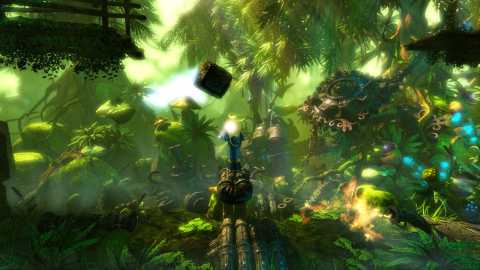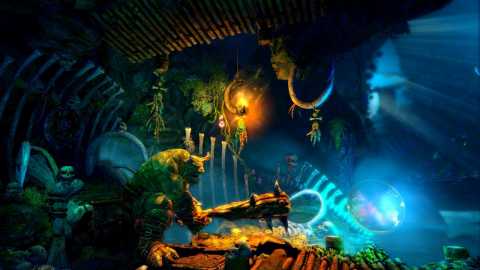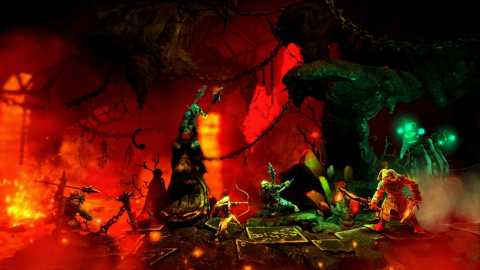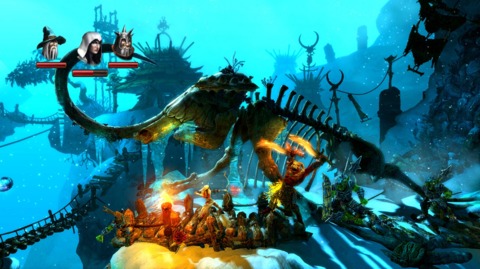
Everything you loved about Frozenbyte's beautiful 2009 puzzle-platformer Trine is present, and in most cases improved, in the new sequel out now for PC, Xbox Live Arcade, and PlayStation Network. With more involved puzzle mechanics and even lusher visuals--which is really saying something, considering that first game was quite a looker itself--Trine 2 feels like a genuine step up from its impressive predecessor. Everything about the game is better in only an incremental way, leading to the occasional feeling of excessive familiarity. But then, Trine was already so good that it's hard to argue with more of the same great game, right?
The side-scrolling puzzle mechanics in Trine 2 are taken directly from the original, meaning everything still hinges on the three-way split between the knight, wizard, and thief characters who are linked together by the mystical soul-binding artifact called the Trine. All three characters handle more or less the same as they did before, and you still have access to a talent tree that provides them pretty much the same abilities, with a few minor additions. The wizard Amadeus again acts as your physics tool, since you can use him to manipulate all sorts of objects in the environment, using the game's robust physics system, and also conjure boxes and planks out of thin air to help you climb about. Zoya, the thief, handles ranged combat with her arrows and is the most nimble character with a grappling hook that gets her swinging from anything made of wood. And the trusty old knight Pontius is mostly here to do the heavy combat lifting with either his sword and shield or a heavier hammer that you can throw around with an optional upgrade.

You're up against a race of burly, green-skinned goblins this time around, and though it's occasionally fun to employ that neat omnidirectional control over the knight's shield and the thief's arrows in a fight, it's often faster to just flail at nearby enemies as fast as you can with your sword, since you'll usually kill all of them before they kill you. The story is just barely more substantial here than in the first game, involving a long lost kingdom and a couple of magical princesses, and it mostly serves to propel you through the game's dozen fantastic chapters set in swamps, caves, and an ice fortress level that's probably one of the most visually stunning video game environments ever rendered.
True, you've seen all these abilities--and the general gameplay model that results from switching between the three characters on the fly to use them smartly in concert--before. Where Trine 2 feels like it moves things forward significantly is in the design of the levels, and the new ways you can influence them. Fluid dynamics play a more central role in much of the puzzle design; there are quite a few instances where you need to direct the flow of water onto magical plants to make them grow to gigantic size, and you can get creative to accomplish that goal by balancing troughs to funnel the water, stacking several conjured planks together, or sometimes just standing underneath a waterfall and raising your shield at the right angle. There are a lot of nifty clockwork machines that you can use the wizard to manipulate, and there are simply more elements in the environment, like the gigantic, springy leaves that grow out of those giant plants that you can grab onto and move around to aid in your puzzle-solving. There's a lot of really satisfying stuff in here in that regard, in the ways you can get hands-on with the vast array of manipulable objects to creatively get past obstacles.

The first Trine offered only local cooperative play, and the sequel improves on this with online co-op that lets all three characters mix it up over the Internet. I played through both Trine games by myself and enjoyed them purely as puzzle-focused action games, but even if you do that too, it's worth going back and at least checking out a few levels with friends later on. It really becomes a different game when you get all three characters in there at once, and not just because that opens up some elaborate new ways you can work together. Griefing each other with your respective abilities can be at least as fun as playing the game the right way. The online co-op worked well for me in general; you can quick-match your way into a random open game, or you can browse a nice list of games showing what level and how many characters are in play. I matched into a couple of games where my character inexplicably refused to respond to the controls, but otherwise online play was functional and relatively lag-free. Offline co-op has a minor camera issue where some characters can disappear off the side of the screen occasionally, which gets awkward, but Frozenbyte has said a fix in the works.
Co-op play is certainly well and good, but the deeper you get into the game, the more puzzles you encounter that seem like they were designed specifically with co-op in mind. The wizard can levitate objects while other characters stand on them, but not when he's standing on them himself, and for that reason alone, obstacles that are a 10-second cooperative trifle suddenly become maddening when you're the only one there to put all the pieces together. In other cases you need to do things like pull and hold a lever to keep a door open, and that requires you to move faster than the game otherwise makes you do when you're by yourself. Other times you'll find yourself awkwardly trying to climb up a rickety stack of conjured boxes to get somewhere that wouldn't be so hard to reach if you just had a little help. Nothing in the game is insurmountable in single-player, but it would've been nice if some of the solutions felt a little more elegant when you're playing alone.
On top of the generally improved core gameplay, Trine 2 has some more nice options and refinements around the periphery. Naturally, you can revisit any chapter at will after you've finished the story, bringing in all of your unlocked abilities, and in addition to the ubiquitous experience orbs there are also collectible paintings and poems to find. There are no achievements pertaining to collectibles or level progress, though; the game admirably focuses all 12 of its achievements on unique challenges that push the game mechanics to the extreme, like surfing an air current on one of the wizard's planks for four seconds, or shooting three arrows into the air with the thief and catching them on the knight's shield. Say what you want about achievements in general, but this specific set of them is a great way to help you wring some unusual extra gameplay out of Trine 2. Probably the best new thing in the game is the "unlimited" mode that opens up after you finish the story, which lets you play a version of co-op where each player can use any character at any time, meaning you can have three wizards in there creating enough boxes to completely overrun the screen if you want. That gets as ludicrous as you expect it would.

You just can't talk about Trine 2 without mentioning how painfully gorgeous it is. Cue half a dozen superlatives talking about the lavish detail and eye-popping visual effects slathered all over every scene, but seriously, this has to be one of the best-looking games made to date. Just look at some videos of it to see why. The only thing you could say against the game's visual design is that it runs at 11 for the entire game; every single scene is so dense with small details and numerous glowing, over-saturated colored light sources that it would be nice to also see similar technology and artistic sensibilities applied in a more reserved fashion from time to time. Your eyeballs feel like they might get cavities. I'm heaping all this praise mainly on the PC version, which is easily capable of running at 60 frames per second at really high resolution; I played it on my TV at 1080p with a wireless controller, and it was glorious. The Xbox 360 version is much lower-resolution and runs at a frame rate that's steady but appeared to be barely at 30, or maybe a bit below. That candy-coated art style still shines through on the console, though, and if that's your only way to play Trine 2, you won't be disappointed. But play the PC version if you can.
The best thing about Trine 2 is that even with its notable set of improvements, at $15 it's still a good bit cheaper than the first game was at release. With a lower price, must-see visuals, and unique platforming that works well by yourself and better with friends, Trine 2 makes for a nice little bite-size piece of entertainment during this otherwise slow holiday period.